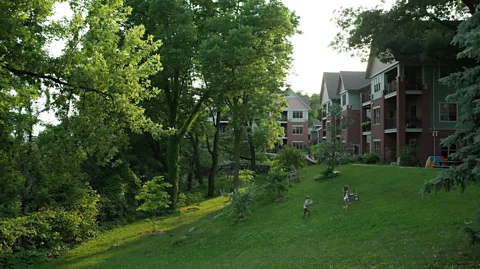Amidst the growing cost of living and concerns about loneliness on a global scale, intentional communities are gaining popularity. We speak with co-living members to weigh the advantages and disadvantages.
Living with unfamiliar individuals can bring upon challenges such as constantly occupied bathrooms, dirty dishes in the sink, and loud music from neighboring rooms disrupting your sleep. However, perhaps there is another way. With housing and rentals remaining expensive and the World Health Organisation recognizing loneliness as a significant issue, communal living is receiving attention from the media and seeing an increase in community-driven living arrangements. The real question is whether society is ready for this alternative way of living together.
Help With The Chores
 Benedikte Kluver
Benedikte Kluver
At 30 years old, Rosie Kellett is a food writer who resides in London. Last year, after a breakup, she found herself in need of a new place to call home. Scrolling through social media, she stumbled upon an available warehouse - an old industrial building. According to Kellett, there are nearly 100 of these warehouse communities in Hackney Wick where she currently lives. However, her living situation is unlike the others. "We have our own unique setup," she explains.
 Benedikte Kluver
Benedikte Kluver
At their Hackney Wick warehouse, Kellett and her housemates often host suppers known as "supper clubs". According to Kellett, the best part about communal living is the constant companionship. The people she lives with feel like family, unlike any previous roommates she's had. However, finding a suitable home in London is challenging due to the housing crisis. Living communally provides an opportunity to beat the system. Despite its benefits, there are also downsides. For instance, Kellett has to make an effort to have some time alone. She admits that it's tough to walk away from a large group of people around a table. Even if she chooses not to join in on a party, the noise can still be heard. While sharing two showers and toilets isn't much of an issue for them, having only one washing machine can be inconvenient at times.
Residents of the communal warehouse typically have a stay of several years, whereas other communal living options are designed for long-term accommodations. For example, Creal Zearing, 36, resides in a co-house community in Madison, Wisconsin with her spouse and three-year-old daughter.
 Creal Zearing
Creal Zearing
At the Madison, Wisconsin-based Arbco co-housing estate, there are expansive communal areas. According to Zearing, who spoke with the BBC, her husband purchased their first unit after three months of dating. She was immediately intrigued by the concept of co-housing and saw potential for her and her partner's future if they stayed together. Now, living among around 100 residents of various family dynamics, from families with children to single older individuals, Zearing describes Arbco's two apartment blocks and several single-family houses. Each unit is equipped with its own bedroom, bathroom and kitchen. She clarifies that while their co-house is legally considered a condominium association, they still pay a monthly condo fee which supports the shared spaces and provides insurance coverage for their individual houses.
Co-living tips
- Have regular house meetings to address any issues
- Be prepared to put in some work – everyone needs to contribute
- Make sure you also get time away from your housemates
Residents take turns hosting meals every few weeks and also enjoy various social events, such as a monthly singalong and parties. The community holds a member meeting every fortnight, along with board and committee meetings. Zearing, who works full time, acknowledges that there are likely more regular activities among the retired residents that she misses out on. Each resident is responsible for contributing four hours of work per month.
'Intentional communities'
There is a diverse range of communal living arrangements in Western society, stemming from various causes. The Guardian reports that the Covid-19 pandemic played a role in increasing interest in communal living in the UK. In 2023, members of a successful communal-living center in Suffolk shared with BBC that their setup was providing protection from the high cost of living. According to Penny Clark, a board member at Diggers and Dreamers who specializes in "intentional communities," this topic can be quite confusing. Intentional communities, as defined by academics, consist of five or more unrelated individuals voluntarily residing together. In co-housing, residents have their own individual homes but also share designated communal spaces; while in housing co-ops, ownership is collective but the community may not necessarily exhibit intentional characteristics.
 Getty Images
Getty Images
In a shared living situation, all residents are responsible for contributing to the upkeep and smooth operation of the household. This includes individual living spaces and communal areas. However, it is important to note that these homes are not considered intentional communities.
On the other hand, there are also less common forms of intentional communities, such as Kellett's warehouse or close-knit house shares with friends or chosen family members. These may be less structured and more natural in their formation due to smaller group sizes.
According to academics, what sets communes apart from other communities is their emphasis on communal income sharing. In this type of community, individuals contribute their earnings into a collective pool and make decisions together on how to spend them.
Many people are drawn to communal living for various reasons. Some may be seeking a more environmentally sustainable lifestyle while others value the social connections and sense of belonging in today's increasingly disconnected society. In fact, research suggests that those who live in intentional communities have a quality of life comparable to the happiest members of society.
However, communal living is not without its challenges. As Clark explains, it requires compromise and can be overwhelming at times. Unfortunately, there are also instances where things do not work out positively and individuals may leave feeling upset.
 Getty Images
Getty Images
Although communal living may not align with traditional Western notions of a fulfilling life, its effectiveness is becoming more evident. However, establishing a new co-housing community is no easy feat. The search for suitable land, financial uncertainty, and reluctance from banks pose significant challenges. According to Clark, society tends to value privacy and individual ownership, making communal living an unconventional choice. In fact, the idea of sharing living space is often viewed as unappealing rather than desirable. As a result, the concept of a "good home" is often associated with large, single-occupancy houses.
Despite these obstacles, existing communities such as Arbco regularly receive inquiries from individuals interested in joining. Similarly, after Rosie Kellett shared glimpses of her living arrangement on Instagram, she received numerous requests to move in. However, she explains that they were not accepting new roommates at the time and acknowledges that there is a demand for more shared living spaces. Yet successfully organizing such arrangements can be challenging and requires initiative from individuals themselves.